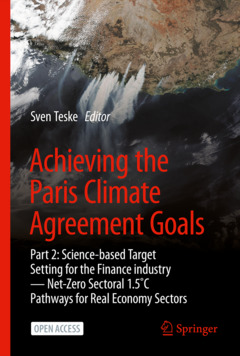Achieving the Paris Climate Agreement Goals , 1st ed. 2022 Part 2: Science-based Target Setting for the Finance industry — Net-Zero Sectoral 1.5˚C Pathways for Real Economy Sectors
Coordonnateur : Teske Sven

This open access book is designed as a continuation of the editor?s 2019 book Achieving the Paris Climate Agreement Goals. This volume provides an in-depth analysis of industry sectors globally, and its purpose is to present emission reduction targets in 5-year steps (2025 to 2050) for the main twelve finance sectors per the Global Industry Classification System. This scientific analysis aims to support the United Nations Principles for Responsible Investment initiative to give sustainability guidance for the global finance industry. The industry sector pathways presented here are based on the latest global and regional 100% renewable energy and non-energy greenhouse gas Representative Concentration Pathways in order to keep climate change significantly under +1.5 C and thereby achieve the Paris Climate Agreement goals.
The heart of this book is three chapters presenting the results of industry scenario modelling. These chapters cover twelve industry and service sectors as well as transportation and buildings. The specific energy demand and specific emissions are presented based on the emission accounting concept of ?Scope 1, Scope 2 and Scope 3? emission pathways. This methodology has been developed to measure the climate and sustainability index for companies, and this research project expands the methodology to apply it to entire industry sectors. The results presented here are the first overall industry assessments under Scope 1, 2 and 3 from 2020 through 2050. The base for the energy pathways is the scenarios scenarios published in the previous volume. The nonenergy GHG emission scenarios, broken down to agriculture & forestry and industry, are detailed and include all major greenhouse gases and aerosols. The final section of the book presents the main conclusions of the industry pathway development work and recommendations for the finance industry and policy makers. Additionally, future qualitative future investment requirements in specific technologies and measures are presented.
Chapter 1: Science-based industry GHG targets, Nationally Determined Contributions (NDC) and the scientific status quo of climate change.- Chapter 2: Development of industry GHG emission and energy demand– past, present and future perspectives.- Chapter 3: Industry GHG target setting, Scope 1, 2 and 3 emissions – the concept.- Chapter 4: Modelling approaches.- Chapter 5: Main assumptions for Industry pathways.- Chapter 6: Renewable Process Heat.- Chapter 7: Renewable Fuels: Hydrogen-, Synthetic- and biofuels.- Chapter 8: Negative emissions: Nature-based-solutions.- Chapter 9: Industry energy pathways - Scenario results.- Chapter 10: Scope 3 industry emissions and future pathways.- Chapter 11: Mapping out Carbon Conservation and Protection Zones (CCPZ).- Chapter 12: Discussion, Conclusions and Recommendations.
Presents detailed net-zero greenhouse gas emission pathways by 2050
Offers non-energy greenhouse gas mitigation scenarios
Provides missing link between target setting for specific industries and the measures to achieve them
This book is open access, means you have free and unlimited access
Date de parution : 08-2022
Ouvrage de 384 p.
15.5x23.5 cm
Disponible chez l'éditeur (délai d'approvisionnement : 15 jours).
Prix indicatif 42,19 €
Ajouter au panierDate de parution : 08-2022
Ouvrage de 384 p.
15.5x23.5 cm
Disponible chez l'éditeur (délai d'approvisionnement : 15 jours).
Prix indicatif 52,74 €
Ajouter au panier


